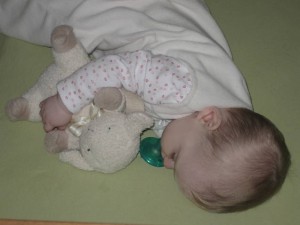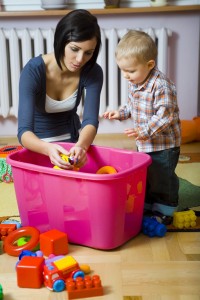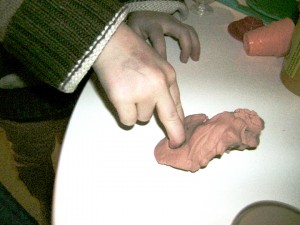December’s blog topic is how we can encourage children’s development and kindergarten readiness with toys. Today’s post looks at learning opportunities as kids play with stuffies. These days, not just animals and teddy bears are stuffed, but cars, dinosaurs, fruit, vegetables, monsters, and more, all come in a practically unlimited variety of colors and sizes. Play time is just as varied.
 Wee little ones play with stuffies very differently than older kids. For babies, stuffies encourage reaching, holding, grabbing, exploring the texture and feel with fingers, toes, mouths, etc. Even before babies play with stuffed toys by themselves they learn to follow the movement of a stuffie with their eyes. Just holding a stuffie a short distance away and then moving it closer to tickle a baby’s tummy begins programming the brain for playing. In this case the game is: Here it is over here. It comes closer and closer and tickles. Then, it happens again. Babies practice anticipating and predicting and more importantly, begin to participate in the interaction.
Wee little ones play with stuffies very differently than older kids. For babies, stuffies encourage reaching, holding, grabbing, exploring the texture and feel with fingers, toes, mouths, etc. Even before babies play with stuffed toys by themselves they learn to follow the movement of a stuffie with their eyes. Just holding a stuffie a short distance away and then moving it closer to tickle a baby’s tummy begins programming the brain for playing. In this case the game is: Here it is over here. It comes closer and closer and tickles. Then, it happens again. Babies practice anticipating and predicting and more importantly, begin to participate in the interaction.
For older kids, some learning fun includes carrying, holding, counting, colors, sizes, textures, balancing, and names of body parts. Children imagine and create all kinds of games with their stuffies. Favorite stuffies encourage different social skills, too, such as caring about and forming relationships. Ever had to search the house in the dark hours for a lost beloved stuffed toy? That piece of fabric with some soft filling has taken on an identity that is important to your child. Stuffies are a super example of how something can be greater than the sum of it’s parts. Stuffie play makes a critical science concept easier to learn and builds memory skills. When you search through your memory banks, can you remember a favorite stuffed toy? (Mine was a blue, pink, and lilac bunny–in a plaid pattern.)
These are just a few of the ways that children learn and develop readiness for kindergarten as they play with stuffies. Stuffed toys are the top of the list when it comes to hours used in a day! What was your favorite stuffy? How does your child play and learn with stuffies?


